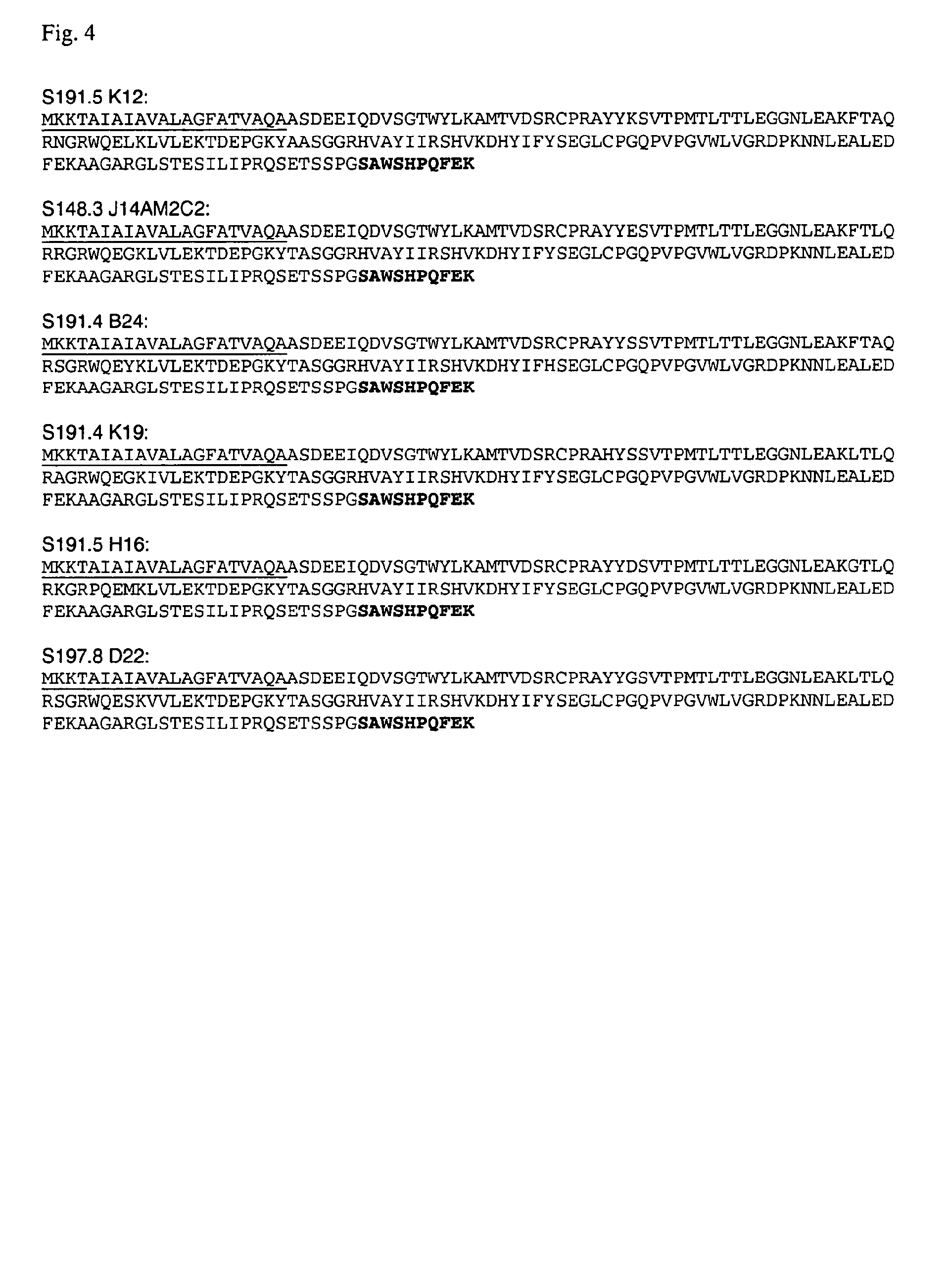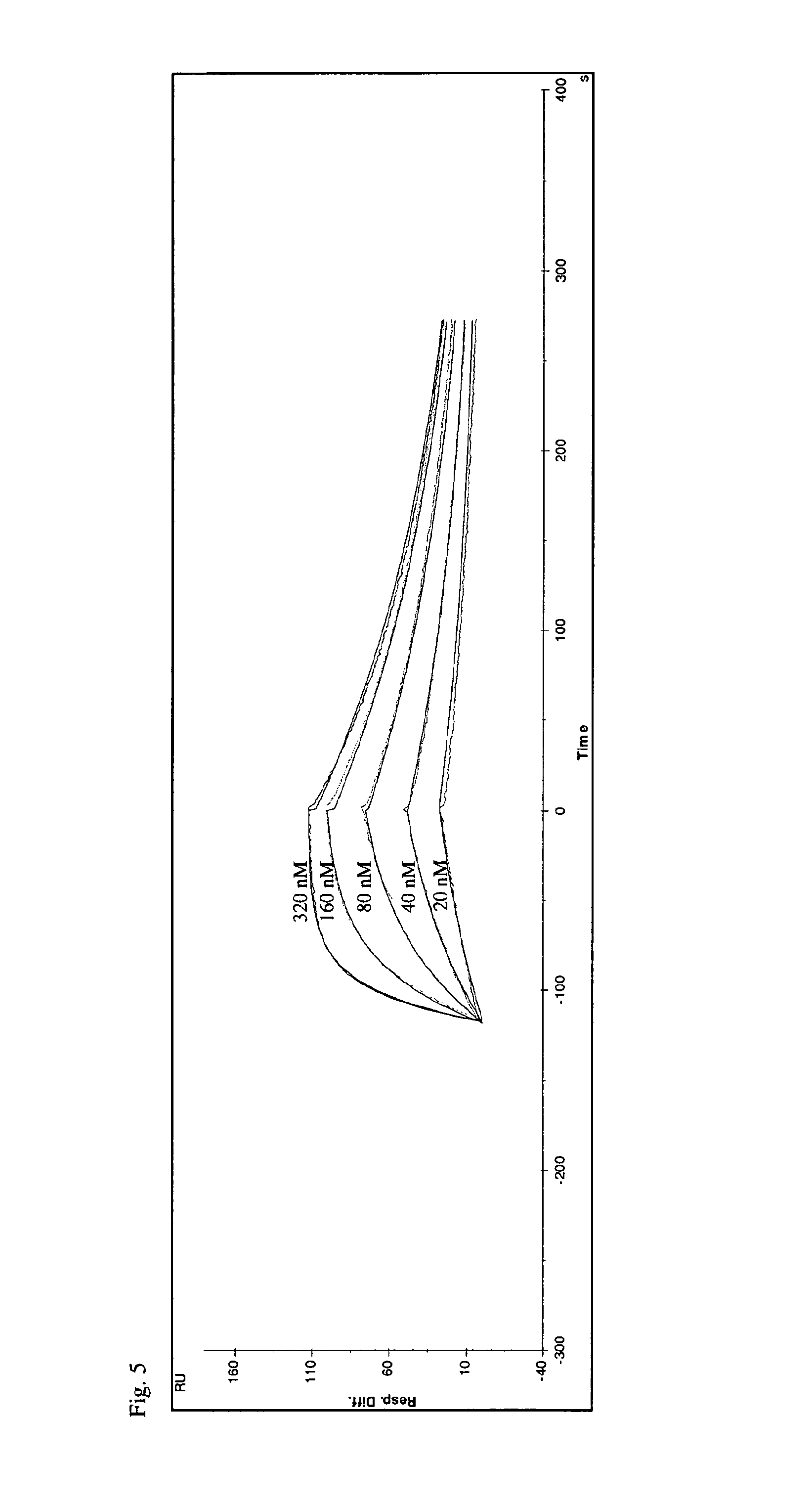Muteins of tear lipocalin and methods for obtaining the same
- Summary
- Abstract
- Description
- Claims
- Application Information
AI Technical Summary
Benefits of technology
Problems solved by technology
Method used
Image
Examples
example 1
Generation of a Library with 2×109 Independent TLC Muteins
[0253]A random library of tear lipocalin (Tlc) with high complexity was prepared by concerted mutagenesis of the 18 selected amino acid positions 26, 27, 28, 29, 30, 31, 32, 33, 34, 56, 57, 58, 80, 83, 104, 105, 106, and 108 of the mature wild type human tear lipocalin. To this end, a gene cassette wherein the corresponding codons were randomized in a targeted fashion was assembled via polymerase chain reaction (PCR) with degenerate primer oligodeoxynucleotides in two steps according to a strategy described before (Skerra, A. (2001) “Anticalins”: a new class of engineered-ligand-binding proteins with antibody-like properties. J. Biotechnol. 74, 257-275). In this library design the first 4 N-terminal amino acid residues (HHLA) as well as the two last C-terminal amino acid residues (SD) of the wild type sequence of tear lipocalin were deleted (for this reason, all tear lipocalin muteins shown in the attached Sequence Listing ha...
example 2
Phagemid Presentation and Selection of Tlc Muteins with Affinity for IL-4 Receptor Alpha
[0265]Phagemid display and selection was performed employing the phagemids obtained from Example 1 essentially as described in WO 2006 / 56464 Example 2 with the following modifications: The target protein (IL-4 receptor alpha, Peprotech) was employed at a concentration of 200 nM and was presented to the library as biotinylated protein with subsequent capture of the phage-target complex using streptavidin beads (Dynal). Alternatively, the target protein was employed as Fc-fusion protein (IL-4 receptor alpha-Fc, R&D Systems) at a concentration of 200 nM and subsequent capture of the phage-target complex using protein G beads (Dynal) and by immobilization of Fc-fusion protein on anti-human Fc capture antibody (Jackson Immuno Research) coated immunosticks (Nunc) according to the instructions of the manufacturer. Three or four rounds of selection were performed.
example 3
Identification of IL-4 Receptor Alpha-Specific Muteins Using High-Throughput ELISA Screening
[0266]Screening of the muteins selected according to Example 2 was performed essentially as described in Example 3 of WO 2006 / 56464 with the following modifications: Expression vector was pTLPC10 (FIG. 1). Target protein used was IL-4 receptor alpha-Fc (R&D Systems) and IL-4 receptor alpha (Peprotech) both at 2 μg / ml.
[0267]Screening 5632 clones, selected as described in Example 2, lead to the identification of 2294 primary hits indicating that successful isolation of muteins from the library had taken place. Using this approach the clone S148.3 J14 (SEQ ID NO:2) was identified. The sequence of S148.3 J14 is also depicted in FIG. 2.
PUM
| Property | Measurement | Unit |
|---|---|---|
| Molar density | aaaaa | aaaaa |
| Molar density | aaaaa | aaaaa |
| Molar density | aaaaa | aaaaa |
Abstract
Description
Claims
Application Information
 Login to View More
Login to View More - R&D
- Intellectual Property
- Life Sciences
- Materials
- Tech Scout
- Unparalleled Data Quality
- Higher Quality Content
- 60% Fewer Hallucinations
Browse by: Latest US Patents, China's latest patents, Technical Efficacy Thesaurus, Application Domain, Technology Topic, Popular Technical Reports.
© 2025 PatSnap. All rights reserved.Legal|Privacy policy|Modern Slavery Act Transparency Statement|Sitemap|About US| Contact US: help@patsnap.com



